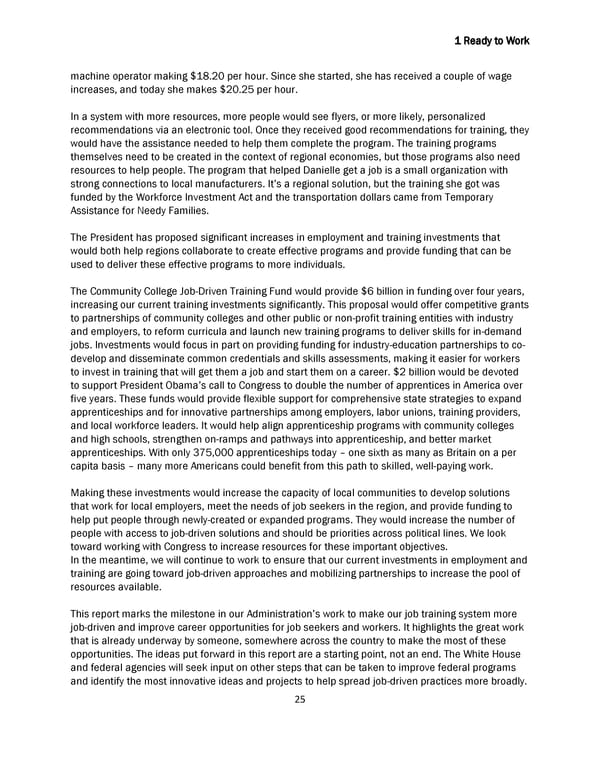1 Ready to Work machine operator making $18.20 per hour. Since she started, she has received a couple of wage increases, and today she makes $20.25 per hour. In a system with more resources, more people would see flyers, or more likely, personalized recommendations via an electronic tool. Once they received good recommendations for training, they would have the assistance needed to help them complete the program. The training programs themselves need to be created in the context of regional economies, but those programs also need resources to help people. The program that helped Danielle get a job is a small organization with strong connections to local manufacturers. It’s a regional solution, but the training she got was funded by the Workforce Investment Act and the transportation dollars came from Temporary Assistance for Needy Families. The President has proposed significant increases in employment and training investments that would both help regions collaborate to create effective programs and provide funding that can be used to deliver these effective programs to more individuals. The Community College Job-Driven Training Fund would provide $6 billion in funding over four years, increasing our current training investments significantly. This proposal would offer competitive grants to partnerships of community colleges and other public or non-profit training entities with industry and employers, to reform curricula and launch new training programs to deliver skills for in-demand jobs. Investments would focus in part on providing funding for industry-education partnerships to co- develop and disseminate common credentials and skills assessments, making it easier for workers to invest in training that will get them a job and start them on a career. $2 billion would be devoted to support President Obama’s call to Congress to double the number of apprentices in America over five years. These funds would provide flexible support for comprehensive state strategies to expand apprenticeships and for innovative partnerships among employers, labor unions, training providers, and local workforce leaders. It would help align apprenticeship programs with community colleges and high schools, strengthen on-ramps and pathways into apprenticeship, and better market apprenticeships. With only 375,000 apprenticeships today – one sixth as many as Britain on a per capita basis – many more Americans could benefit from this path to skilled, well-paying work. Making these investments would increase the capacity of local communities to develop solutions that work for local employers, meet the needs of job seekers in the region, and provide funding to help put people through newly-created or expanded programs. They would increase the number of people with access to job-driven solutions and should be priorities across political lines. We look toward working with Congress to increase resources for these important objectives. In the meantime, we will continue to work to ensure that our current investments in employment and training are going toward job-driven approaches and mobilizing partnerships to increase the pool of resources available. This report marks the milestone in our Administration’s work to make our job training system more job-driven and improve career opportunities for job seekers and workers. It highlights the great work that is already underway by someone, somewhere across the country to make the most of these opportunities. The ideas put forward in this report are a starting point, not an end. The White House and federal agencies will seek input on other steps that can be taken to improve federal programs and identify the most innovative ideas and projects to help spread job-driven practices more broadly. 25
 Biden Ready to Work White Paper 7/22/14 Page 24 Page 26
Biden Ready to Work White Paper 7/22/14 Page 24 Page 26